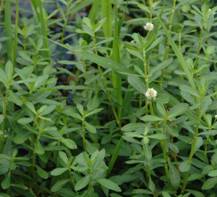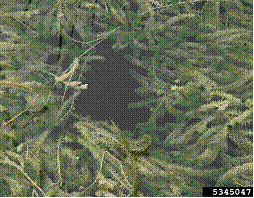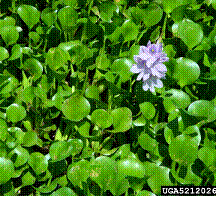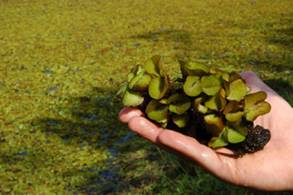Fort Worth District
Lakes and Recreation Menu
Aquatic Species Page
Click on a Subject to access Information - Click "Return to Top" to return to this list
Aquatic Invasive/Nusiance Species
Alligatorweed
Giant Salvinia
Hydrilla
Waterhyacinth
Alligatorweed
Caryophyllales > Amaranthaceae >
Alternanthera
philoxeroides
(Mart.) Griseb.

Chris Evans, River to River CWMA, Bugwood.org
Alligatorweed roots in wet soils or shallow water and grows out into waterways. It forms thick mats that can displace native vegetation and wildlife habitat, clog waterways, restrict oxygen levels of water, increase sedimentation, interfere with irrigation and prevent drainage.
Alligatorweed is an emergent or rooted floating plant that invades aquatic areas and adjoining uplands throughout the southern portions of the United States. Flowering occurs in the summer with white, clover-like heads. Alligatorweed is native to South America and was first introduced into the United States around 1900 in ballast water.
Giant salvinia
Hydropteridales > Salviniaceae >
Salvinia
molesta
D. S. Mitchell
Giant salvinia is a floating fern native to South America that was first introduced into North America as an ornamental. It damages aquatic ecosystems by outgrowing and replacing native plants that provide food and habitat for native animals and waterfowl. It blocks out sunlight and decreases oxygen in water, often killing fish and other aquatic animals. When mats of salvinia die and decompose, it lowers oxygen in the water even more. Giant salvinia spreads very rapidly. It can double in about a week.
Giant salvinia has floating leaves that are 0.5 to 1.5 in. long, oblong, and vary in color from green to gold to brown. The surfaces of the leaves have rows of arching hairs that look like little egg-beaters. Submerged fronds are "stringy" and resemble roots. Plants reproduce by spores and by budding of broken stems or attached nodes.
Hydrilla
Hydrocharitales > Hydrocharitaceae >
Hydrilla
verticillata
(L. f.) Royle

David J. Moorhead, University of Georgia, Bugwood.org
Hydrilla forms dense mats at the surface of the water. The dense mats can restrict native vegetation, irrigation practices, recreation, hydroelectric production, and water flow. It can invade most slow-moving or still water systems.
Hydrilla is a submersed, rooted aquatic plant that can grow in water up to depths of 20 ft. Hydrilla is believed to be native to Asia or Africa, although it is widely spread across the globe. It was first introduced into North America as an aquarium plant in the 1950s.
Waterhyacinth
Liliales > Pontederiaceae >
Eichhornia
crassipes
(Mart.) Solms

Katherine Parys, Louisiana State University, Bugwood.org
Waterhyacinth invades lakes, ponds, rivers, marshes, and other types of wetland habitats. It reproduces quickly and can form dense floating mats of vegetation. Populations can double in size in two weeks! These dense mats reduce the light availability for submersed plants and aquatic invertebrates, and deplete the oxygen levels.
Waterhyacinth is a free floating aquatic plant that has invaded aquatic areas throughout the eastern and southern portions of the United States. The very showy blue-purple flowers are born on upright spikes. Waterhyacinth is native to South America and was first introduced as an ornamental into the United States in 1884 at the Cotton States Exposition in New Orleans.




